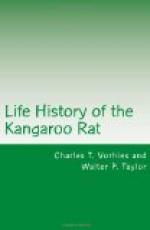Amaranthus palmeri,
Sesuvium portulacastrum, and Atriplex
wrightii (alluvial
soil of Santa Cruz Valley, Continental, Ariz.,
Bailey).
Cut leaves and stems
of a small sagebrush (Franklin Mountains,
Tex., Gaut).
Gutierrezia heads (San Juan Valley, N. Mex., Birdseye).
Verbesina enceliodes,
Portulaca oleracea, Bouteloua gracilis,
and Munroa squarrosa
(Rio Alamosa, N. Mex., Goldman).
Tops of buds of Artemisia
filifolia (Mesa Jumanes, N. Mex.,
Gaut).
Tumbleweed (Amaranthus
graecizans), Russian thistle (Salsola
pestifer), Munroa
squarrosa, and Sporobolus cryptandrus
strictus (Sandia
Mountains, Albuquerque, N. Mex., Vorhies).
BURROW SYSTEMS, OR DENS.
The burrow system, or den, in which spectabilis stores its caches of food materials, has its nest, and remains throughout the hours of daylight is a complicated labyrinth of tunnels. Ejection of refuse and soil from this retreat builds up the mound frequently referred to. These mounds are, as Bailey says, characteristic of the species, and are as unmistakable as muskrat houses or beaver dams, and as carefully planned and built for as definite a purpose—home and shelter. They are, furthermore, the most notable of all kangaroo rat dwelling places (Nelson, 1918, 400). They range in height from 6 inches to approximately 4 feet and from 5 to 15 feet in diameter.
The mound is built up not only through the cleaning out of chaff and other food refuse, but through extension and modification of the tunnels; old tunnels, entrances, and caches of musty food material are from time to time closed up and others excavated, repair and rebuilding being especially necessary after the collapse of portions of the den as a result of heavy rains or trampling by cattle. Ejected material is most commonly simply thrown out fan-wise from the openings, without much apparent effort to add to the height of the mound.
There are usually from 6 to 12 entrance holes in each mound opening into the subterranean burrow system, each hole from 4 to 5-1/2 inches in diameter. These holes are nearly all situated a little above the surface of the surrounding soil, and as Price has suggested (in Allen, 1895, 213), this is doubtless a wise provision against flooding, as torrential rains sometimes occur in the kangaroo rat country.
Both Bailey and Nelson state that as a rule several of the holes are closed with sand or miscellaneous earth and old storage material during the daytime, but our observations on the Range Reserve are that such closing is only occasional. Many occupied dens have not a single opening closed. Further, night observations disclose that the inhabitant of the mound will appear from some one of the two or three most-used openings when night falls, and not necessarily from one which has been closed by day. Recently an opening closed one day was observed in use during the night, but was left open all the next day.




